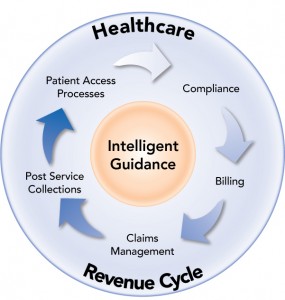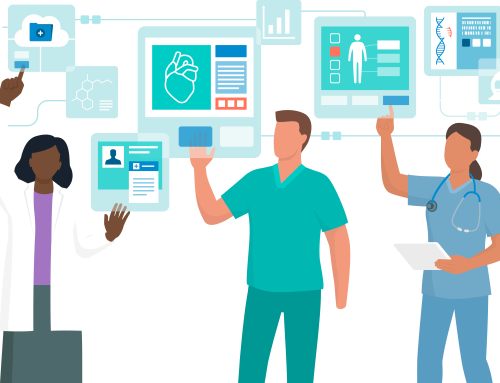The healthcare revenue cycle management environment is ever-changing, but continued advances in technology help healthcare professionals be more effective and efficient during each step of the process. Thanks to new software, increased portability, and a transition to electronic health records, ease of use is increasing swiftly.
But before we dive into the details of technology’s place in the healthcare revenue cycle, it’s important to understand the basics of the revenue process.
So what does the healthcare revenue cycle look like?
It’s much more than making sure final payment is received.
The revenue cycle begins with the patient’s first interaction when scheduling an appointment and health insurance information is collected. It then moves to point of service collections, Encounter Utilization Review and case management, coding, claim submissions, third party follow-up, remittance processing/rejections, and then onto payment, appeals, or collections.
At the core of the cycle is intelligent guidance, which means proper training, attention to detail, and consistent oversight. The intuition of technology is limited; computers can only be as intelligent as the individuals who utilize them.
Technology Solutions
One of the major stumbling points in the healthcare revenue cycle is that the systems implemented are not seamless, and thus lead to disjointedness.
And while technology and software constantly changes and improves, healthcare providers sometimes find themselves sticking with whatever solution is already in place. However, these areas should be focal points to help improve the revenue cycle:
- Contract analysis: In contract negotiations, proper data can be an asset that is leveraged. It also helps provide a big picture view of contracting processes and shed light on revenue opportunities with payers.
- System integration: Healthcare records, accounting, billing, and collection systems should all work together seamlessly via an investment in current software and/or hardware.
- Coding: Correct coding is essential to proper billing and payment collection. It will help reduce over-billing and during an audit.
- Billing/claims management: Reducing rejected claims and proper handling of denial management improves the efficiency of the revenue cycle.
Why is Technology Important?
You may be asking yourself, “But what’s wrong with the old systems?”
It’s simple. When these systems fail, it negatively impacts the healthcare facility’s bottom line. And since data is falling between the cracks, it’s difficult to identify where the problem is occurring. Yes, implementing new technology in the healthcare revenue cycle can be a significant investment–but you must also consider the lost revenue resulting from that dated technology. We recommend conducting a cost/benefit analysis to see if a technology upgrade may be worthwhile.
When executed with the proper technology, a strong revenue cycle is a core pillar of a successful healthcare system. The systems work together to create a full narrative of what is happening during this cycle, and can give a health report on where the organization stands, as well as areas for improvement.
What technology improvements have you made in your healthcare revenue cycle that made a noticeable difference?








Great article! Thank you for sharing.
RT @BHMHealthcare: Technology’s Place in Healthcare Revenue Cycle Management: How Technology Improves the Healthcare Revenue Cycl… http:/…
RT @BHMHealthcare: Technology’s Place in Healthcare Revenue Cycle Management: How Technology Improves the Healthcare Revenue Cycl… http:/…
Thanks for your feedback Miguel A Lopez Mba!
RT @BHMHealthcare: How technology is helping #healthcare systems improve their revenue cycles: http://t.co/hkeRAp9Fiv http://t.co/q9pUQNT8Xw
Miguel A Lopez Mba liked this on Facebook.